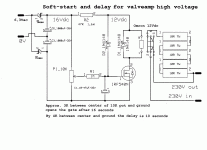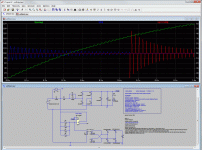Sorry, no.
I'm pretty poor with modern PCs and I find it easier to just draw with pencil and paper.
Pc's are irritating......I have an old HP scanner for my paper drawings...sometimes a photo with the mobile 🙂
But I have to try and get your asc files out one way or another.
regards Gudmund
.asc files are opened with LTSpice.
Jwilhelm,
Thank you. I did manage to open the asc files with LTSpice.....I was not aware that you even had modified the asc files to PDF files
Regards Gudmund
You can with appropriate component values get very reliable triggering of the relay using circuits like this.
I have done a few.
I prefer using a 555 timer. It costs much the same and is very consistent.
Could you in short terms explain the "MyRefC_24V_A.asc"?
You have two psu's...one for the 1440R coil ..24Vdc....and another full bridge supply taken from the same transformer...2 x 24Vdc.
You did also mention a delay circuit with a 555 timer...may be on 12Vdc?
myrefC is the amplifier I copied into LTspice.
24V is the voltage I adopted.
A is the first modifcation to get the myrefC relay driver circuit to work better than as drawn.
Similarly
Nabucco supplied a sch for a relay driver and the PCB.
drawn into LTspice.
24V is the voltage I adopted.
A is the first modifcation to get the myrefC relay driver circuit to work better than as drawn.
Similarly
Nabucco supplied a sch for a relay driver and the PCB.
drawn into LTspice.
myrefC is the amplifier I copied into LTspice.
24V is the voltage I adopted.
A is the first modifcation to get the myrefC relay driver circuit to work better than as drawn.
Similarly
Nabucco supplied a sch for a relay driver and the PCB.
drawn into LTspice.
Ok..I will have a closer look at your "myrefC".
I know you don't like the resistor R3 which I used as a voltage divider in parallel with the electrolytic capacitor of 1000uF/25V.
When the 12Vdc is applied, I have checked the voltage across the capacitor to be approx. 1,5Vdc. I have tried to change the capacitor to a tantalum 100uF/16V, and at the same time changed R2 to 220K and R3 to 33K. This setup gives me approx. 5 seconds delay, by R3 at 22K the delay is approx. 2 seconds..... exact the same delay repeated several times.
The circuit triggers and works the same way down to 8Vdc applied.
By 12Vdc applied the voltage across the 100uF/16V tantalum is the same 1,5Vdc. I have heard that tantalum capacitors are very stable and solid components. Can I have your opinion on this one?
I have used a few tantalum in past decades.
Until I read here that they have a terrible reputation for failing.
Further reading suggests that they should never be exposed to a DC voltage exceeding half their voltage rating.
I have since tried a few sticking rigidly to that <50% rule, since many opamp manufacturers still specify tantalum for MF decoupling of the supply rails.
I have NEVER had a tantalum fail, but I have probably used less than 50 in my projects.
Until I read here that they have a terrible reputation for failing.
Further reading suggests that they should never be exposed to a DC voltage exceeding half their voltage rating.
I have since tried a few sticking rigidly to that <50% rule, since many opamp manufacturers still specify tantalum for MF decoupling of the supply rails.
I have NEVER had a tantalum fail, but I have probably used less than 50 in my projects.
That is good.The circuit triggers and works the same way down to 8Vdc applied.
I have used a few tantalum in past decades.
Until I read here that they have a terrible reputation for failing.
Further reading suggests that they should never be exposed to a DC voltage exceeding half their voltage rating.
I have since tried a few sticking rigidly to that <50% rule, since many opamp manufacturers still specify tantalum for MF decoupling of the supply rails.
I have NEVER had a tantalum fail, but I have probably used less than 50 in my projects.
Nice information to have that tantalum should not exceed more than half of their voltage rating!
I have seen tantalum capacitors used in safe protection circuits where precise timing are required. I found some information from this Vishay PDF file:
http://www.vishay.com/docs/49268/tn0003.pdf
DC Leakage Failure Mode
Vishay
DC leakage current is present in all tantalum capacitors.
This leakage level is low and stable and should not
compromise circuit performance. In timing circuits,
the charging current should be at least 10 times the
DC leakage current of the capacitor. For example, a
5 V volt timing circuit with a 100 KΩ series resistor and a 47 μF
capacitor requires a capacitor with a maximum 5 μA leakage
current over the operating temperature range
Thanks for your calculations and advises.
Regards Gudmund
Soft-start for tubeamp
This attached circuit is a copy from "Leakstereo20":
"For soft-start of a valve amplifier the attached delay circuit has just been tested and works ok.
The intention was to use the power transformer and the existing heater supply of 6,3Vac.
The circuit includes a voltage doubler, a IRF540N fet and a 12Vdc Omron relay.
The delay by 4K between the center adjustment of the 10K pot and ground stays around 10 seconds, which should be enough for sufficient heater-glow. Otherwise it is possible to extend the delay time."
https://sites.google.com/site/https...dc-speakerprotection/leak-stereo-50-softstart
Gudmund
This attached circuit is a copy from "Leakstereo20":
"For soft-start of a valve amplifier the attached delay circuit has just been tested and works ok.
The intention was to use the power transformer and the existing heater supply of 6,3Vac.
The circuit includes a voltage doubler, a IRF540N fet and a 12Vdc Omron relay.
The delay by 4K between the center adjustment of the 10K pot and ground stays around 10 seconds, which should be enough for sufficient heater-glow. Otherwise it is possible to extend the delay time."
https://sites.google.com/site/https...dc-speakerprotection/leak-stereo-50-softstart
Gudmund
Attachments
Last edited:
Gudmund
You may be interested in this thread:
http://www.diyaudio.com/forums/powe...it-design-other-psu-issues-6.html#post4220583
I have been using ver 1.3 of my board (see thread) ahead of 162,000uF and a 350VA transformer for quite some time now. Works like a charm. (BTW the NTC doesn't even get warm.)
You may be interested in this thread:
http://www.diyaudio.com/forums/powe...it-design-other-psu-issues-6.html#post4220583
I have been using ver 1.3 of my board (see thread) ahead of 162,000uF and a 350VA transformer for quite some time now. Works like a charm. (BTW the NTC doesn't even get warm.)
Gudmund
You may be interested in this thread:
http://www.diyaudio.com/forums/powe...it-design-other-psu-issues-6.html#post4220583
I have been using ver 1.3 of my board (see thread) ahead of 162,000uF and a 350VA transformer for quite some time now. Works like a charm. (BTW the NTC doesn't even get warm.)
I have read your thread.
I have to say that I prefer an auxiliary transformer supply for the delay circuit, rather than taking the delay supply from the mains 230Vac.
I think it is more safe with a small secondary 12Vac transformer.
The circuit in post #12 only shows the serial resistor inrush current limiter on the primary side. The idea was to try and use the second relay contacts for a NCT on the secondary transformer side... slower inrush current/voltage for the capacitors.
Might not be necessary with the NCT??
Regards Gudmund
Fair enough. Yes, the timing circuit is fed from the mains, rectified and regulated to 24V but it is predictable within mains/component tolerances and adjustable. Rather simple. It is an improvement on the circuit/boards sold at the DIYaudio store (which I think has some issues). A timing IC will give you more accurate timing control (unaffected by mains supply voltage variations) but you have to ask yourself whether you really need it. A few milliseconds here or there isn't so critical.
How are you going to power your 'auxiliary transformer supply' if not from the mains?
If the in-rush limiter is placed on the primary side, everything downstream benefits - the entire inrush associated with energising the toroid(s) and the charging of the filter capacitance is managed. The two aspects aren't isolated in a typical setup.
I have attached a zip folder of my LTspice models for this circuit and earlier variants (including the one sold in the store) just in case you want to have a play with it (e.g. varying the key timing control components R3 and C3 or mains supply variance). The relevant file for the circuit I am using is softstart-hysteresis-ntc.asc.
Anyway, I thought it might be useful.
How are you going to power your 'auxiliary transformer supply' if not from the mains?
If the in-rush limiter is placed on the primary side, everything downstream benefits - the entire inrush associated with energising the toroid(s) and the charging of the filter capacitance is managed. The two aspects aren't isolated in a typical setup.
I have attached a zip folder of my LTspice models for this circuit and earlier variants (including the one sold in the store) just in case you want to have a play with it (e.g. varying the key timing control components R3 and C3 or mains supply variance). The relevant file for the circuit I am using is softstart-hysteresis-ntc.asc.
Anyway, I thought it might be useful.
Attachments
Fair enough. Yes, the timing circuit is fed from the mains, rectified and regulated to 24V but it is predictable within mains/component tolerances and adjustable. Rather simple. It is an improvement on the circuit/boards sold at the DIYaudio store (which I think has some issues). A timing IC will give you more accurate timing control (unaffected by mains supply voltage variations) but you have to ask yourself whether you really need it. A few milliseconds here or there isn't so critical.
How are you going to power your 'auxiliary transformer supply' if not from the mains?
If the in-rush limiter is placed on the primary side, everything downstream benefits - the entire inrush associated with energising the toroid(s) and the charging of the filter capacitance is managed. The two aspects aren't isolated in a typical setup.
I have attached a zip folder of my LTspice models for this circuit and earlier variants (including the one sold in the store) just in case you want to have a play with it (e.g. varying the key timing control components R3 and C3 or mains supply variance). The relevant file for the circuit I am using is softstart-hysteresis-ntc.asc.
Anyway, I thought it might be useful.
Your spice models and soft-start PCB looks very professional, and I am convinced that your circuit works very well.
The precise timing is not that important to me, but you see... the DIY work does matter to me...I like to test the circuits.
Rod Elliott advises to use a small secondary transformer as supply for the delay circuit, and of course I have to use the 230Vac mains to switch-on the large toroidal transformer....but by 230Vac on the primary side and only 12Vac/100mA on the secondary, it is possible to use a soft-touch Swiss made quality switch to turn-on the delay circuit.
I like to keep a long distance from the 230Vac mains and low voltage circuits......... I think the high voltage regulatory says that there have to be minimum 5 mm distance between the PCB kobberlines from 230Vac high voltage and lower voltage circuits on the same PCB.
....they are quite restrictive with electrical equipment here.
Regards Gudmund
Last edited:
What do I do with all the other files in the .zip to allow the .asc to run with all the components in place?
I too like to run all the auxiliaries from a separate transformer or if suitable from separate windings on the main transformer........................Rod Elliott advises to use a small secondary transformer as supply for the delay circuit, and of course I have to use the 230Vac mains to switch-on the large toroidal transformer....but by 230Vac on the primary side and only 12Vac/100mA on the secondary, it is possible to use a soft-touch Swiss made quality switch to turn-on the delay circuit.
I like to keep a long distance from the 230Vac mains and low voltage circuits.........
Soft start and remote off/on using LV touch switch are but two examples that particularly suit a separate isolation transformer fed from it's own Mains fuse.
What do I do with all the other files in the .zip to allow the .asc to run with all the components in place?
Is this question in relation to the zip I posted? If 'yes':
- you can just leave everything in the folder. If all .asc, .lib files and .asy symbol files are in the same folder then LTspice should run the models fine without change.
Here's what's in the folder:
- there are 4 .asc models in the folder. softstart.asc is a model of the DIYstore circuit. softstart-ntc.asc replaced the resistor bank with an ntc. The two 'hysteresis' models added Mark Johnson's suggested hysteresis to each of these. As you know, I really just continued to work with the softstart-hysteresis-ntc version to completion.
- the .plt models for each of the above is what is generated when you save the form of the plot output so that each time the model is run you don't need to add traces and set plot settings etc.
- the .asy files are symbols in LTspice. Non native (i.e. those not included in LTspcie by LT) need to be transported with the .asc file. Only rly_dpdt and ntc_resistor.asy are used in the hysteresis-ntc version.
- .lib or .txt files are model/subcircuit files that are linked to by .include statements in the .asc files. Saves cluttering the .asc file with .model statements. So if there is a need for a third-party model in the .asc model you need to describe it somewhere. You can see the .asc files are a mix of including sub circuit and model statements in external files via .include and some where I just included them in the .asc file itself.
So if ever you want to share your LTspice work with someone else (and as good practice anyway) it is important that all the necessary files are in the same folder as your .asc files. All the third party or self-created symbols, .model statements, .subcircuit statements etc. If they aren't all there, the .asc won't run properly. Never use local links to files stored in user directories for example as the person you want to share your work with will get an error that they can't link to the file on your computer.
Makes sense?
OK, I'll try again.
I could see the basic sch, but the relay and the NTC were missing and the warnings came up.
This is where the extracted files have ended up. "soft start LT spice model" just after the ONsemi directory
Is that right?
Note, I did not put them into the offered "download" directory.
Can I delete the Macosx directory?
I could see the basic sch, but the relay and the NTC were missing and the warnings came up.
This is where the extracted files have ended up. "soft start LT spice model" just after the ONsemi directory
Is that right?
Note, I did not put them into the offered "download" directory.
Can I delete the Macosx directory?
Attachments
Last edited:
It loads and runs.
Does the relay coil voltage (grn) rise like that?
It is desperately slow and will probably chatter as it reaches the first turn on voltage.
What is the red trace?
Where is the NTC?
Does the relay coil voltage (grn) rise like that?
It is desperately slow and will probably chatter as it reaches the first turn on voltage.
What is the red trace?
Where is the NTC?
Attachments
Last edited:
I can't see what's in the _MACOSX folder. If there is nothing in it then yes. I don't use Windows at home but I zipped a folder of files so you should be able to extract the folder as a whole (rather than the files individually). If not, the easiest thing is likely to select 'Make New Folder' which is perhaps what you did. (I can't see from your image what's in the folder Soft Start LTspice Model under ltspicefiles but the pane in the background has all the files in a folder under Downloads.)
In any event, just make sure everything is in the same folder. The error you got means the symbols files / .lib files etc weren't in the same place (or weren't extracted from the zip).
In any event, just make sure everything is in the same folder. The error you got means the symbols files / .lib files etc weren't in the same place (or weren't extracted from the zip).
- Status
- Not open for further replies.
- Home
- Amplifiers
- Solid State
- Simple soft start current limiter for DC-amp


